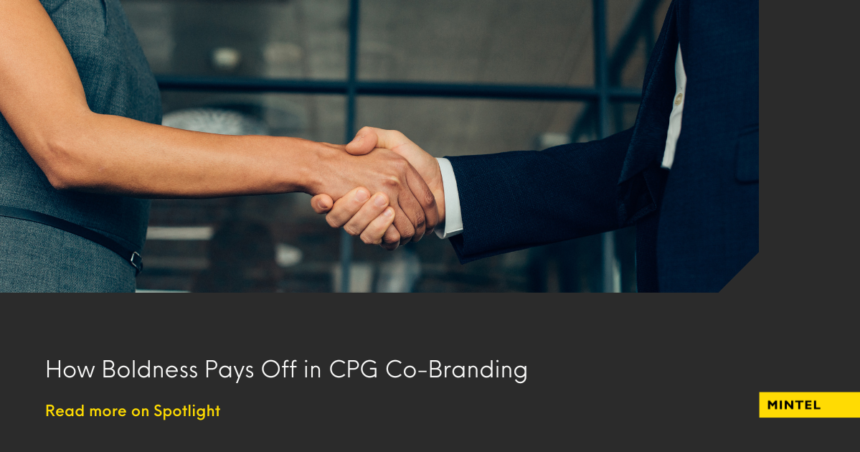In the ‘Insight to Impact with Mintel Consulting’ series, thought leaders on our Marketing Intelligence team expand on research and insights identified in Mintel Comperemedia research. Today’s article is inspired by the co-branded credit card space (client link only) and how brand partnerships permeate other industries, such as drinks, beauty, and others.
Think about the most recent airline you flew on, the last big retailer you shopped at: Chances are, their names are on a credit card.
In the credit card industry, co-brand cards exist because: 1) two brands identify that there are upsides to this partnership, 2) both brands believe there is enough affinity between the two, and 3) because of this aforementioned affinity, they can target each other’s audiences and thus gain market share in a very competitive landscape.
Of course, every relationship has its ups and downs. For example, Citibank and American Airlines celebrated 35 years of their partnership last year, while Walmart is currently suing Capital One in an attempt to end their relationship, stating that Capital One “was consistently unable to meet the customer-service standards” outlined in its contract, such as issuing replacement cards and promptly processing payments and posting transactions.
But what about the CPG industry? How do brands in the food, drink and beauty space approach partnerships? We can certainly leverage Mintel Marketing Intelligence to answer that.
The more (partnerships), the merrier
In March 2023, beauty brand e.l.f. announced its partnership with apparel brand American Eagle on a limited “Beauty Is In Your Jeans” makeup collection. The partnership is a first for both brands – the first time for e.l.f. partnering with an apparel brand, and the first time American Eagle is partnering with a beauty brand. Despite being their first time collaborating, both brands have a lot in common, starting with their focus on Gen Z. While this approach will not necessarily help both brands expand their audiences, it will give them a broader customer base—and one they’re very familiar with.
This is by no means e.l.f.’s first partnership – it partnered with Dunkin’ in 2022 for its limited-edition makeup collaboration. The partnership was inspired by people’s morning must-haves, such as “making a Dunkin’ run wearing your favorite e.l.f. makeup,” as Kory Marchisotto, e.l.f.’s CMO, puts it. This strategy can help e.l.f. to position makeup as a morning staple, just like breakfast.
And of course, e.l.f. is meeting its audience where they are, prioritizing paid social (TikTok, Instagram) over other channels.

Starting an argument conversation
In March 2023, Ice cream brand Van Leeuwen partnered with salad dressing brand Hidden Valley to launch a limited-time only (yes, this is going exactly where you think is going) ranch-flavored ice cream. The owned-TikTok post below shows media outlets and celebrities reacting exactly as you might expect someone would react if a pint of ranch ice cream is put in front of them: surprise, doubt, but most importantly, curiosity and a willingness to try it.
Just curiosity alone can push people that are not even familiar with Van Leeuwen to try the brand, thus helping with brand awareness and recall.
These types of partnerships/strategies would, of course, never work in the credit card industry. Credit card partnerships must have staying power, and given the nature of the industry, need to be more professional.
If it works, then let it stay
A lot of partnerships in the CPG industry are for a limited time only, but that is not the case for sports nutrition brand Ghost or energy drink brand C4.
Back in 2018, Ghost partnered with Swedish Fish to create a Swedish Fish flavored BCAA’s (a performance supplement). The partnership is still going strong, expanding into other Ghost products, such as its energy drink in 2022.
C4, on the other hand, it’s a long-time partner of Mars Wrigley, featuring flavors such as Starburst, and launching a Skittles-flavored energy drink in 2022.
Both Ghost and C4 are relatively new brands. Having long-term partnerships with long-established brands such as Swedish Fish and Skittles can help both brands gain awareness and brand trust in a competitive market. Long-established brands can also benefit from these partnerships; they can associate their legacy names with younger brands, positioning themselves as innovative brands, despite their long-lasting presence in the market.

What we think
Brands thinking about whether or not to embark on a partnership with another brand should consider the impact of two words: customer motivation. According to Mintel data, the number of US adults that would be motivated to buy more frozen treats if they were co-branded grew from 32% in 2022 to 34% in 2023, while 35% of US adults agree they are likely to try a snack featuring flavors from other foods.
Aside from customer motivation, partnerships in the CPG industry are a tool for relatively new brands to build awareness by leveraging their partnerships with more established brands. Even though most partnerships in the CPG industry have an expiration date, it is important for brands to consider if a temporary collaboration can evolve into a more permanent partnership that will benefit both brands in the long run.
It is also important to understand that, at the end of the day, partnerships are just that – partnerships. This means that both brands need to make a shared effort to bring a new vision to life and excite their audiences.
If you’re interested in learning more about CPG brand partnerships from Mintel Consultancy, please reach out to speak with a Consultant.








